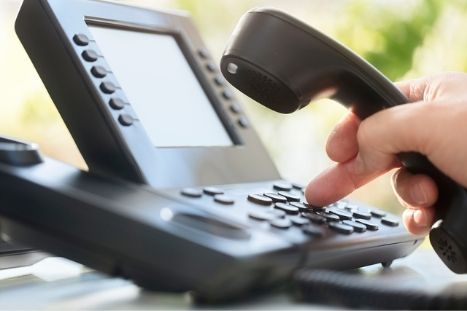 If you’re working to grow your business, odds are good that you’re eager to address as many inquiries and customer concerns as possible. When each ring of the telephone represents a new opportunity to win over customers, it’s important to treat each call with care and attention. This requires a lot more time and effort than many small business owners realize. Call handling overflow strategies can help combat the tidal wave of inbound calls.
If you’re working to grow your business, odds are good that you’re eager to address as many inquiries and customer concerns as possible. When each ring of the telephone represents a new opportunity to win over customers, it’s important to treat each call with care and attention. This requires a lot more time and effort than many small business owners realize. Call handling overflow strategies can help combat the tidal wave of inbound calls.
Of course, each of these strategies have their pros and cons. Some have withstood the test of time. Others are aging poorly. If you recognize your own company’s strategy for handling high call volume below, it may be time to reflect on what is – or isn’t – working for your customers.
What are the Most Popular Ways to Handle Business Phone Call Overflow?
Of course, every business handles call overflow management in their own way. What’s right for a popular nail salon might not work for a busy pediatrician’s office. By understanding your organization’s unique needs and challenges, you can choose the call handling overflow strategy that’s right for your customer base. Here are a few of the most popular options:
Letting the Phone Ring
Perhaps the easiest – and most disruptive – way to handle high call volume is to let the phone simply ring. The shrill sound of an incoming call might be just annoying enough to motivate employees to stop what they’re doing and come to the phone. While this strategy has remained popular throughout the decades, it’s not one we’d recommend to any business hoping to curate valuable customer experiences.
Employee morale may also begin to suffer. When there’s not a dedicated receptionist on hand to answer calls, the chore falls to everyone in the office. If nobody feels especially duty bound to answer the phone, staff members may grow resentful of one another, keeping mental notes on who is helping stem the tide and who is letting the phone ring off the hook. It’s a recipe for frustration that is certain to bleed over into your customer service offerings.
This business call handling strategy is difficult enough before you factor in the current labor shortage. It’s challenging to multitask and present a professional first impression to callers, but even more so when you’re working on a skeleton crew. Too often, letting the phone ring is less of a call handling technique than it is a necessary evil. It’s not one we’d recommend using for long.
Putting Callers on Hold
Another popular but inadvisable strategy for handling high call volume is the classic hold. We’ve all been there before: you dial up a business, eager for support, but find yourself deflated as you’re almost instantly placed on hold. It’s a surefire way to inspire frustration in your callers. Nobody likes being put on hold, and the longer the wait, the more the caller’s impatience grows. By the time an agent is available to speak with the caller, they’re more likely to be short-tempered and unwilling to tolerate additional wait time. It’s enough to drive many customers into the arms of your competition.
This strategy is equally as frustrating for employees. Without enough manpower to meet demand, employees are stretched too thin. They often have no choice but to put callers on hold, and by the time they return to a particular conversation, they’re met with angry, impatient customers looking for someone to blame for their wait. High volume customer service is often demoralizing for everyone involved.
Sending Calls to Voicemail
Call handling overflow techniques don’t get more hands off than this. A favorite strategy of busy entrepreneurs everywhere, letting customers roll to voicemail is an easy way to convince yourself that you’re staying on top of inbound calls. It’s especially useful when receiving a call during a meeting, while you’re away from your desk, or when you’re in the middle of a particularly challenging task.
The problem? In our 24/7 world, voicemail has become passe. A relic from the days when we weren’t constantly plugged in, voicemail’s very existence feels outdated. There’s also the reality that nobody likes leaving or listening back to the voicemails they receive. It’s a chore for both parties. In fact, upon hearing voicemail pick up is enough to motivate many callers to hang up and call up another company instead of bothering to leave a message and wait for a returned call.
Leaving Calls for Staff to Answer
If there’s one thing customers want when dialing your business, it’s a speedy response. Failing to answer the phone quickly enough is often a massive red flag for prospective new customers. This is often the case, though, when calls are left for the entire staff to answer collectively. In terms of call management techniques, this option is one of the least effective. That’s because when nobody in particular is in charge of answering the phone, nobody will feel motivated to take a proactive role in actually handling inbound calls.
Unfortunately, this business call handling strategy is all too common, especially in new companies just finding their customer base. Without money in the budget for hiring a dedicated administrative professional, many new business owners place call handling duties on the collective shoulders of their team. It’s a recipe for resentment, frustration, and poor customer experiences.
Even when you do have the staff buy-in necessary for high volume phone calls, this strategy can be detrimental to your team’s overall rate of productivity. While we might all imagine ourselves as incredible multitaskers, the reality is that humans are actually terrible at doing two things at once. In fact, research shows that we’re actually 40 percent less productive when multitasking than when we’re focused on one task at a time. Though leaving calls for staff to answer might seem like an economical alternative to hiring a receptionist, this strategy may actually cost you more in the long run.
Using an Answering Service
This is perhaps our favorite call handling overflow technique of all – and we don’t say that just because we’ve offered such services for more than three decades! Relying on high volume call center services to answer your phone is an economical solution to one of the most challenging administrative headaches. Partnering with such a service comes with a lot of benefits. A better customer experience is chief among them. Customizable options are available to suit your particular organization’s needs, allowing you to match your brand voice and tone so operators represent your business in every conversation.
Partnering with a call overflow management service can bring an immediate sense of relief for your in-house team. Without the ringing of the telephone constantly interrupted employee concentration, who knows what your team might accomplish? By passing customer support on to virtual receptionists and call center workers, your employees can focus their attention on more urgent tasks. An answering service can provide a cushion against the tidal wave of inbound calls, connecting your team only when necessary.
An answering service can also provide a serious boost to your organization’s credibility. Highly-trained, professional virtual receptionists are entirely focused on the customer experience. They work tirelessly to deliver questions to frequently asked questions, schedule appointments, place orders, and even provide tier one tech support. This level of service is sure to delight callers and inspire them to ring your company again soon.
Why Partner with MAP Communications
When it comes to business call handling services, you’ve got no shortage of options from which to choose. Over the last 30 years, MAP Communications has risen to the top of the industry. That’s because we know there’s nothing quite as important as a first impression. Businesses around the country entrust their inbound calls to MAP knowing that we’ll handle each conversation with professionalism and resourcefulness. Look no further than our testimonials page for evidence of our long-term success.
Featuring some of the fastest pick-up times in the industry, the MAP Communications name has become synonymous with quality. Should you decide to partner with us to address high call volume, count on the MAP team to deliver the kind of customer service you’ve always dreamed of offering. You’ll be treated to your own nationwide 800 number, online account analytics, access to our in-house IT team, along with dynamic online account access.
Try Our Live Answering Service for Free
Are you ready to level up your customer service offerings and handle high call volume challenges once and for all? MAP Communications is offering a free week trial of our live answering service. For one week, you’ll be privy to all the benefits of a partnership with MAP. That means no more calls interrupting your workflow, no more middle of the night client calls, and no more irate customers threatening to take their business elsewhere at the first sign of a wait.
Ready to sign up for the trial? Simply click here to answer a few questions about your business and one of our helpful receptionists will be in touch shortly!




